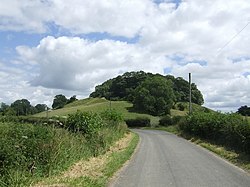Caus Castle
| Caus Castle | |
|---|---|
| Westbury,ShropshireinEngland | |
 | |
| Coordinates | 52°39′45″N2°58′36″W/ 52.662539°N 2.976543°W |
| Grid reference | SJ340076 |
| Type | Hill fortandmedievalcastle |

Caus Castleis a ruin of ahill fortandmedievalcastlein thecivil parishofWestburyin theEnglishcounty ofShropshire.It is situated up on the eastern foothills of theLong Mountainguarding the route fromShrewsbury, ShropshiretoMontgomery, Powys,on the border betweenEnglandandWales.It was destroyed during theEnglish Civil Warand has been in ruins since.[1]
History
[edit]The early outer earthworks of the site are probably anIron Agehillfort,while the latermotte-and-baileyis of Norman construction.
Roger leCorbet(or Fitz Corbet) was granted severalmanorsinShropshirein 1069 byWilliam the Conqueroras theBarony of Causfor his role in theNorman conquestand invasion of England. They were named after hisNormandyestate in thePays de Caux,in France. TheCorbetsowed fealty toRoger de Montgomery,the firstEarl of Shrewsburyto help controlWelsh Marcheswith absolute control over theirdemesne.Caus Castle was built by Roger le Corbet in the late 11th century as a highmottewith a very small summit on which stood a tower and a strongly defended inner bailey.
The castle was sufficiently important that the Crown took an interest in its maintenance.Henry II of Englandhad it garrisoned in 1165. In 1198 Roger Corbet re-built the tower, keep and curtain wall in stone. During the late 12th century a town orboroughwas founded in the large outer bailey. A royal grant of 50 marks was made in 1263 towards further building work when D-shape towers were added to the curtain wall. The town contained a church of St Margaret as well as the castle's church of St Nicholas, and the names of two thoroughfares, Castle Street and St Margaret Street are recorded.[2]On the death of Beatrice Corbet in 1347, Caus passed to theEarl of Stafford.At its height, the borough had 58burgessesresident in 1349, a year coinciding with the arrival of theBlack Death in England.
Caus (alternatively spelt Caux or Cause) was garrisoned by theSeneschalGriffith ap Ieuan ap Madoc ap Gwenwys against the rebellion ofOwain Glyndŵrin the 15th century, but following calls from Welsh graduates in law and students in theUniversity of Oxfordhe changed sides and supported Glyndŵr. As a result, his family lands and role at Caus Castle were forfeited in 1404, only to be restored byHenry V of Englandin 1419 after his sons Ieuan ap Griffith andSir Gruffudd VychancapturedJohn OldcastleforLord Charlton of Powys.
On 10 August 1443, at Caus CastleSir Gruffudd Vychanpierced with a lance the heart of his master, Sir Christopher Talbot (1419–1443), son ofJohn Talbot, 1st Earl of Shrewsbury,and the champion tilter of England. He was outlawed, a reward of 500 marks (£166 6s 8d) offered for his capture, and his lands were passed toJohn Sutton, 1st Baron Dudley,as the death of the young knight was not regarded as an accident. TheEarlsandBarons Staffordrarely used the castle in the 15th and 16th centuries so that it was recorded in great decay in 1521,[3]and had only two resident tenants in 1541.[2]Henry Stafford, 1st Baron Stafford(fourth creation) recordedly died there in 1563 when he was buried atWorthen.[4]
The castle was given as part of a marriage settlement toJohn Thynne (died 1604)andJoan(née Hayward), butEdward Stafford, 3rd Baron Stafforddisputed the ownership. After he and Joan forcibly ejected Stafford from Caus Castle, in 1591, Joan lived at Caus whist John was based atLongleat,Wiltshire. The letters between them illustrate their partnership. Joan appears to have managed many aspects of their estate. She is also credited with defending Caus Castle, keeping guns and gunpowder in her bedroom[5]
A 15th century wooden screen from Caus Castle was later installed inMinsterley Hall,which was built by the Thynne family in 1581.[6]
The castle was finally deserted after it was destroyed during theEnglish Civil Warafter falling as a minor Royalist garrison in June 1645.[1]
However,Katherine Lowtheris said to have been born in Caus Castle in 1653 into the Thynne family. She was a daughter of Sir Henry Thynne, 1st Baronet and Mary Coventry, a daughter of Thomas Coventry, 1st Baron Coventry.[7]
References
[edit]- ^abTrinder, Barrie.A History of Shropshire.p. 57.
- ^abTrinder, Barrie (1983).A History of Shropshire.Phillimore & Co Ltd. p. 36.ISBN0-85033-475-6.
- ^"Caus Castle".
- ^Dictionary of National Biography, 1885-1900, Volume 53, Stafford, Henry (1501-1563)retrieved 27 January 2018
- ^"Thynne [née Hayward], Joan, Lady Thynne (bap. 1558, d. 1612), gentlewoman".Oxford Dictionary of National Biography.doi:10.1093/ref:odnb/64886.Retrieved6 December2020.
- ^Historic England."Minsterley Hall, Minsterley (1055191)".National Heritage List for England.Retrieved26 September2018.
- ^Matthew, H. C. G.; Harrison, B., eds. (23 September 2004),"The Oxford Dictionary of National Biography",The Oxford Dictionary of National Biography,Oxford: Oxford University Press, pp. ref:odnb/67731,doi:10.1093/ref:odnb/67731,retrieved21 December2022
Sources
[edit]- Barker, P.A. (1981). 'Caus Castle and Hawcocks Mount'Archaeological JournalVol 138 p34
- Chitty, L. F. (1954).Caus CastleThe Hundred-and-First Annual Meeting: Programme, CAA p19-21
- Williams G. (1998). 'Sir Gruffydd Fychan (?-1447)'Montgomeryshire CollectionsVol 86, p17-28

